
Rendering of Airbus’ MQ-72C, its offering for the Marine Corps’ Aerial Logistics Connector program. (Photo: Airbus)
Airbus U.S. said May 20 it recently completed a second demo to inform its work on the Marine Corps’ Aerial Logistics Connector (ALC) program, which follows a recent announcement it’s working with L3Harris Technologies on the effort to develop an unmanned version of the UH-72 Lakota aircraft.
L3Harris will serve as the lead systems integrator on Airbus’ team for ALC, which is offering the uncrewed MQ-72C for the program to develop an unmanned cargo-carrying platform.
“I’m really excited about this partnership because it brings the best in class from the airframe side, [in terms] of manufacturing and supporting and sustaining rotorcraft, and best in breed from a systems engineering, systems integration, digital backbone and [modular open systems architecture perspective],” Rob Geckle, chairman and CEO of Airbus U.S., said last week during a briefing at the Army Aviation Association of America’s annual conference in Nashville.
The Marine Corps last April selected Airbus for the competitive ALC development effort, with an aim to have a prototype that’s ready to transition into fielding within five years.
Airbus has said MQ-72C, the unmanned version of its UH-72 helicopter being developed for ALC, is intended to have a cruise speed of 135 knots, a maximum takeoff weight of over 8.300 pounds and a range above 350 nautical miles.
“[The MQ-72C] is a low-risk, affordable solution. And we think that’s hitting the sweet spot when you have demanding mission requirements and resource constraints,” Geckle told reporters, noting Airbus has invested $20 million into developing the MQ-72C.
Geckle said Airbus is targeting production of a minimum viable MQ-72C prototype in the 2028 timeframe and then moving toward production of a final design in 2029.
“We plan on being ready for [low-rate initial production], if that’s what NAVAIR wants to do, by 2030,” Geckle said.
The Marine Corps also selected a team led by Near Earth Autonomy, that also includes Honeywell and Leonardo Helicopters, for the ALC development effort.
Airbus said the second program demo for ALC was conducted at Marine Corps Air Station Yuma and evaluating the performance characteristics of the UH-72 Lakota, validating “the aircraft’s ability to load and carry specialized cargo” and detailing how the platform can be modified to meet requirements for an uncrewed cargo-carrying capability.
“This demonstration was another illustration of how our MQ-72C system can support a range of missions and payloads that Marines will need to perform operations in austere environments,” Geckle said in a statement on May 20. “We believe this aircraft will redefine the future of Marine Corps aviation.”
Geckle said last week feedback from the Marine Corps and Naval Air Systems Command is being incorporated into continued development work on the MQ-72C.
L3Harris’ work on the Airbus’ ALC team will include providing a modular open systems architecture (MOSA) for the MQ-72C to serve as the future platform’s “digital backbone.”
“Combined with their modular open systems approach, the infrastructure enables the U.S. Marines to rapidly integrate third-party, commercial off-the-shelf hardware that will enable maximum system versatility and mission adaptability,” Airbus said in a statement last week.
Jason Lambert, L3Harris’ president of intelligence, surveillance and reconnaissance, told reporters the company has invested $24 million of its own research and development dollars into building out the MOSA capability, noting it’s already been fielded as part of its work on the Army’s ATHENA-R interim ISR jet capability.
“So the best thing about this is there’s not the development risk that comes with a traditional DoD program of record,” Lambert said.
In late April, Airbus announced it had partnered with Shield AI to integrate its autonomy software for the MQ-72C, citing the firm’s “record of succeeding quickly” in integrating autonomous capabilities as a key factor in the decision to work together on the ALC program.
“And with Shield AI as our autonomy partner, this reminds me of the 1992 Dream Team back in the Olympics,” Geckle told reporters. “[DoD] wants autonomous solutions. They want something to support missions [for] distributed logistics in contests and semi-contested environments. They want it to be affordable. And they want it to be a platform that can meet the schedule. If you’re using readily available capabilities on the systems integration and MOSA side with aircraft that are readily available with a hot production line, that just helps you on the cost and on schedule.”
Airbus said additional ALC demos are planned for 2025 to “inform future acquisition decisions for the opportunity to build a prototype aircraft.”
“The demos that we’ve done have proven out the capabilities of the airframe itself. And we expect that, in the future, will start proving out the capability and autonomy solutions based on the Marine Corps’ mission requirements,” Geckle said.
Geckle noted Airbus views the MQ-72C as “having utility” beyond the Marine Corps, and the company has “engaged” with the Army’s UAS program office and Contested Logistics Cross-Functional Team to gauge potential interest in the platform.
A version of this story originally appeared in affiliate publication Defense Daily.